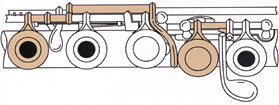Good care and routine maintenance of your flute can insure a lifetime of playing enjoyment. Please carefully read the following to make sure your flute performs at its peak:
Jewelry
Jewelry is a common cause of damage to flutes, especially rings. Some of this damage may not be able to be repaired, particularly to the surfaces in and around the embouchure hole.
Assembling your flute:
- Grasp the body at the barrel joint with one hand and the footjoint at the bottom below the keys with the other hand. Put the pieces together with a twisting (not rocking) action.
- Grasp the headjoint below the lip plate and once again use a gentle back and forth twisting action to fit the body of the flute to the headjoint. Some technicians recommend turning the headjoint onto the barrel only in a single direction.
- Most flutes are designed to be played at A = 442 with the headjoint pulled out 1/8″, but this can be adjusted to your preference.
Swabbing the inside of your flute:
Most professional flutes come with a wooden cleaning rod. You can extend the life of your pads and reduce instrument maintenance by swabbing out your flute with a soft, absorbent cotton cloth after each time that you play.
Fingerprints can be removed by using a microfiber cleaning cloth. Do not use cloths that have been infused with a silver cleaning chemical as these powders can work their way into the mechanism of the flute or onto the pad surfaces. While we do not recommend using silver polish, some players wish to. Use silver polish only with extreme care and never use it on or around the mechanism or pads. Your instrument is best stored in its case when you are not using it. Keep your case clean, and do not store accessories inside the case.
Straubinger pads and their care:
Your flute may have factory installed Straubinger Pads. You will find that these pads will stay in adjustment much longer than ordinary felt pads.
As you clean your flute be careful to stay away from the edges of the pad and key cup. The edges of the Straubinger Pad are very firm and hard and are susceptible to wear if their edges are rubbed frequently.
If you choose not to send your flute back to us for service, we suggest that you work with a technician who has been authorized by us or by David Straubinger to perform the service on your instrument. Call us for a referral to a Lyric Authorized Service Center near you.
Recommendations for maintenance:
Your flute should be cleaned, oiled and adjusted (termed a COA appointment) approximately once each year by a qualified flute repair technician. To make an appointment with us or to locate the nearest authorized Lyric repair center, please call 1-800-967-6733.
We will make any adjustments to your new flute free of charge for 6 months from the date of purchase. This does not apply to instruments which have been adjusted without direct authorization from us. This offer excludes repair work due to accidental damage or misuse.



